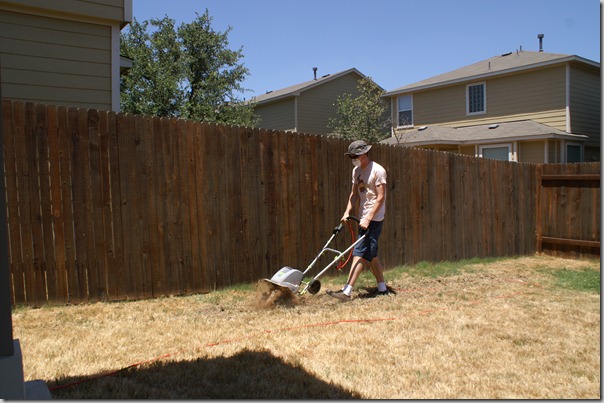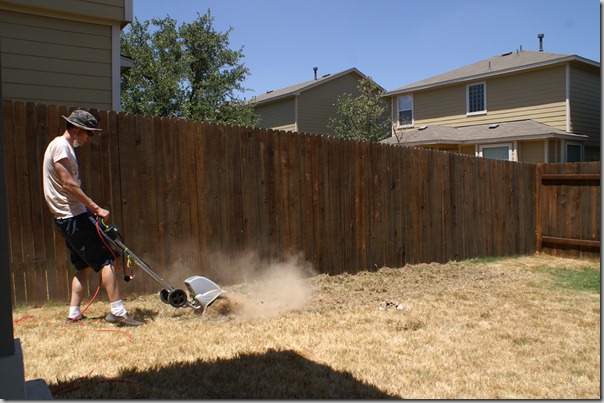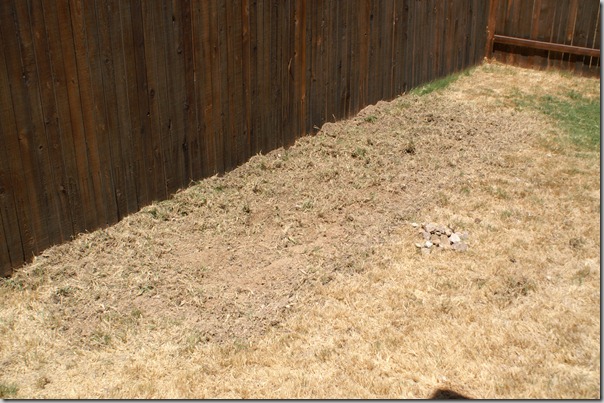Teri and I both have some form of agriculture or home food production in our background. Her father owns farmland near Waco, my mom grew up on an Iowa farm, and my dad’s father maintained a substantial garden as a hobby. When I was younger, my family also operated a garden in our back yard for a few years. So one thing I was excited to start once I had a yard was a vegetable garden of my own.
After Teri and I agreed on the location, it was just a matter of waiting until it was time to get ready for the first planting. To do this, I decided a tiller was going to be a necessity to make this doable, especially since every year will involve tilling in any old growth and some compost. Growing up, we had a serious Honda gas tiller but I figured I could get away with something a bit smaller in our modest yard. After reading some reviews, I decided the Earthwise Cultivator/Tiller sounded like a great deal (it’s a bit more expensive now at $120 than when I bought it, but after using it, I’d say it’s easily worth it).
Although I don’t plan to start gardening in earnest until next Spring (by which time I should have some good compost to work in), I wanted to plant a cover crop this Fall to start getting some nutrients in the soil. I did a soil test a while back and found that our yard has almost no nitrogen and is very alkaline, so it will take some work to turn this into good growing soil. Nitrogen-fixing beans should be a good first step.
Although now is too soon to plant the lima beans, I figured the intense heat of August would be a good time to start killing off the grass and weeds where the plot will be. My initial assumption after reading Monsanto’s marketing was that Roundup would be a reasonable way to do this, so I started watering the area to get the grass out of dormancy so it’d absorb the Roundup better. Before doing this, however, I thought and read some more and decided that spraying Roundup, even if it was well before I’d have any vegetables planted, was not a good idea in a food bed (or, arguably, anywhere) no matter how long it might before we actually have edible crops. Especially since I’m hoping to avoid any non-organic methods for this garden. So I researched other ways of killing off the grass/weeds. One I read was that simply tilling it several times during the heat of the summer would expose the roots to the sun and burn them to death. So that’s the plan.
In order to fully expose all of the grass and weeds to the desiccating solar rays, I’ll need to till it several times over the next few weeks. Since the next few days are forecast to be a scorching 108 degrees here in Central Texas, now sounded like the perfect opportunity to start. (It’s not often that temperatures like this can actually be a good thing!)
The bed is going to be 4’ by 14’ along our North-Western fence, so I measured out the general outline and put some rocks along the border. Next, I fired up the tiller and started doing laps, each a bit deeper than the previous. My goal in this first tilling isn’t to get it perfect or deep, but really just to chop up and expose that grass, so it didn’t take long. The tiller worked wonderfully, too. Plenty of power and it didn’t even get damaged by all the rocks in our yard.


I haven’t bothered watering the back lawn this summer because of the drought, so the tilling up the yard kicked up a ton of dust. Hence the dust mask.

Hard to see the progress since the soil is basically the same color as the grass, but that’s several inches deep and should be plenty to get those roots nice and exposed to the sun. A few more tillings over the next month or so and then it’ll be time to put in the border for the raised bed and probably add some decent soil. Until then, stay cool!

Comments